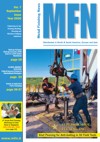E-Archive
Cover Page
in Vol. 7 - September Issue - Year 2006
Shot Peening for Anti-Galling in Oil Field Tools

Drill pipes and tubings

Drill pipes with threaded ends


Superior Shot Peening Inc. in Houston, Texas
In oil-field drilling tools manufacturing, drill pipes and tubings are manufactured with threaded ends. The tubular ends are fixed jointly together, either by a coupling or a pin-to-box connection to form a tubular string for drilling the oil well.
The threaded ends are a cost effective way of connecting the tubular mandrels; however, the objective should be, to have improved oil field tubular connections containing conical metal-to-metal primary sealing surfaces. This protects against galling which could lead to undesired seizure and subsequently to leakage of the sealing surfaces during the make up of the connections.
The metal-to–metal sealing surfaces between the tubular lengths are most commonly frustoconical in configuration. Also, significant axial loads are applied to each connection and when the axial forces increase, the high angle tapered sealing surfaces are susceptible to leakage, whereas low angle tapered sealing surfaces are subjected to galling during the make up operation. So, the design of the tubular connection has to properly balance the static and dynamic forces acting on the sealing surfaces.
Modifications are required for forming a reliable metal-to-metal seal between conically shaped metal surfaces, for static sealing, in the oil field tubular mandrels. In particular, the undesirable galling between metal-metal surfaces during make-up and remake-up of the tubular connections is a significant problem, especially for lengthy, low angle sealing surfaces. Often these metal-metal surfaces produce a desired seal when first made-up, but this metal seal breaks during the repeated "tripping" operation, and subsequently the made- up seal becomes increasingly susceptible to galling.
If galling occurs, the torque will not be converted into the preload of the engaging part due to high friction. Also, threaded galling can become severe enough that the mating parts can seize, making it virtually impossible to separate them. Therefore, galling is a genuine problem which should be considered during the initial design phase.
Galling can occur on threaded connections made of any alloy steel, stainless steel or inconel material which has a naturally formed oxide film on it. When these tubular mandrels are fastened with higher torque levels, the oxide film starts breaking and crumbling down. The accumulated microscopic oxide particles / shavings have rough and sharp edges which can clog or lock together. This cumulative clogging –locking action creates increasing friction and heat. This finally leads to the expansion of the metal, leading to the final seizure or galling. Fortunately, galling does not occur everyday, but when it does it is effectively irreversible. Serious delay and part shortages can occur, and tedious remedies are often required. Such a crisis can be avoided by understanding galling, and by adopting the treatments to prevent it.
There are several methods suggested to tackle the problem of galling. For example application of hard coatings like PVD, PACVD techniques or lubricants, anti-seize compounds like silicone spray, high viscous oil etc. For this tubular, threaded connection application, both technically and economically shot peening seems to be the most effective wise optional solution.
By controlled shot peening of the threads, one can create dissimilarity between the matting surfaces, work hardening the surface, and also reduce the area of contact which reduces the friction between the surfaces. By, using shot peening as an effective tool to tackle galling, one can also take advantage of the benefits of using low cost materials in the manufacturing of these tools.
Galling is more likely to occur when the external threads are cut rather than rolled. Cut threads have rougher surfaces because of the machining process. However, on the rolled threads the effect of cold working is only achieved at the roots and not on the external threads.
So, for oilfield tubular connections, both the cut and rolled threads require a final surface modification treatment of controlled shot peening.
For Information:
Superior Shot Peening Inc.
13930 Luthe Rd, Houston, Texas 77039, U.S.A.
Tel: +1.281.449 6559, Fax +1.281.449 5339
www.superiorshotpeening.com




























